Top 10 Fertilizer Sticks of 2025: Best Picks to Maximize Plant Growth
- April 23, 2024
- 0 comment
Explore the Top 10 Fertilizer Sticks of 2025 to maximize your plant growth efficiently. Perfect for gardeners seeking the best for their plants. Are you looking to give your plants the best possible care? Here’s our expert roundup of the 10 best fertilizer sticks available in 2025, perfect for anyone aiming to enhance their garden’s health and beauty.

From indoor floral arrays to outdoor vegetable patches, these top picks are essential for optimal plant growth. Dive into detailed reviews of each product’s benefits and find the right solution to nourish and flourish your green spaces effortlessly.
List of Top 10 Fertilizer Sticks of 2025
- Earthpods Organic Indoor Plant Fertilizer Spikes
- The Old Farmer’s Almanac Tree & Shrub Fertilizer Spikes
- Miracle-Gro Indoor Plant Food Fertilizer Spikes
- Miracle-Gro Tree & Shrub Plant Food Spikes
- Jobe’s Slow Release Evergreen Fertilizer Spikes
- Jobe’s 5001T Houseplant Indoor Fertilizer Food Spikes
- Miracle-Gro Fruit & Citrus Plant Food Spikes
- The Old Farmer’s Almanac Houseplant & Flower Plant Food Mini Fertilizer Spikes
- Jobe’s All-Purpose Fertilizer Spikes
- Laguna Once-A-Year Aquatic Plant Fertilizer Spike
Why Fertilizer Sticks?

Fertilizer sticks are solid spikes containing essential nutrients that are inserted into the soil near a plant’s root base. Designed to slowly release nutrients into the soil, they provide a steady supply of nourishment that is crucial for the plant’s growth over an extended period. This direct delivery system helps to minimize wastage through runoff and maximizes nutrient uptake.
Benefits of Using Fertilizer Sticks
- Ease of Use: Simply push them into the soil, and they will slowly dissolve and release nutrients.
- Efficiency: They reduce nutrient run-off and are absorbed effectively by plant roots.
- Frequency: They need to be applied less frequently than liquid or granular fertilizers.
- Targeted Application: Reduces the chances of spreading chemicals widely, focusing the growth benefits to the plants that need them.
- Reduced Waste: Their targeted application minimizes runoff and environmental impact.
- Versatility: Suitable for a wide variety of plants, including indoor potted plants, garden flowers, and vegetables.
Ideal Applications: Fertilizer sticks are particularly effective for potted plants and container gardens where nutrient leakage can be a problem. They are also excellent for feeding high-nutrient-demand plants in garden beds, such as tomatoes, peppers, and roses.
Factors to Consider When Choosing Fertilizer Sticks
- Nutrient Composition: It’s important to select a fertilizer stick with the right balance of nitrogen (N), phosphorus (P), and potassium (K), commonly known as the NPK ratio. The ideal ratio depends on the specific needs of the plants being fertilized.
- Plant Specificity: Some fertilizer sticks are formulated specifically for types of plants like flowering species, vegetables, or green foliage plants.
- Soil Compatibility: The effectiveness of a fertilizer stick can also depend on the type of soil it is used in. Some are better suited for clay soils, while others are formulated for sandy soils.
- Release Rate: Choose between slow-release formulas that provide steady nutrients over several months or quick-release types for fast results.
- Environmental Safety: Opt for sticks that are environmentally friendly, with organic certifications where possible, to avoid contaminating the garden ecosystem.
Top 10 Fertilizer Sticks of 2025
1. Earthpods Organic Indoor Plant Fertilizer Spikes
EarthPods Organic Indoor Plant Fertilizer Spikes stand out as one of the top picks for fertilizer sticks in 2025, particularly due to their unique, user-friendly capsule form. These pre-measured, no-mess capsules simplify the plant feeding process immensely; by eliminating the guesswork involved in measuring and the mess typically associated with granular or liquid fertilizers, EarthPods make it possible for even novice gardeners or those with physical limitations to nourish their plants effectively. Each capsule is packed with over 70 organic nutrients and trace minerals, which not only mimic the nutrient-rich composition of forest earth but also ensure a balanced diet for plants, promoting vibrant foliage, strong stems, and robust roots.

This proprietary blend is designed for extended, time-released delivery of nutrients, providing continuous nourishment that helps plants thrive over time. The all-natural, sustainable ingredients further enhance this product’s appeal, making it an eco-friendly choice for indoor gardeners looking to foster lush, healthy plant growth without harsh chemicals.
Pros:
- No-mess, easy-to-use capsules perfect for quick application
- Comprehensive nutrient blend supports all-around plant health
- Eco-friendly, made from sustainable resources and packaged with recycled materials
Cons:
- Requires consistent reapplication every 2-4 weeks for best results
- Priced higher than some traditional fertilizer forms due to premium ingredients
2. The Old Farmer’s Almanac Tree & Shrub Fertilizer Spikes
The Old Farmer’s Almanac Tree & Shrub Fertilizer Spikes offer a distinct advantage as one of the top fertilizer sticks for 2025 due to their robust, slow-release formula and ease of use. These spikes are designed with the TruSpikes technology, which ensures they are easy to insert into the ground without breaking or crushing a common issue with similar products. This feature is particularly beneficial for providing uninterrupted nutrition to trees and shrubs, as it minimizes the mess and hassle during application.

The inclusion of natural ingredients like molasses not only enriches the soil with a 13-3-3 blend of essential nutrients (13% Nitrogen, 3% Phosphorus, 3% Potassium) but also enhances nutrient uptake at the root zone, promoting healthier, more vibrant plant growth. This product is ideal for gardeners looking for a reliable, mess-free solution that supports the health and beauty of their large plants and contributes to their overall gardening success.
Pros:
- Durable and easy-to-use spikes prevent breakage when hammering into the soil.
- Nutrient-rich formula with natural ingredients supports comprehensive plant development and root strength.
- Only needs application twice a year, providing convenience and sustained benefits.
Cons:
- Limited to use with trees and shrubs, not suitable for all plant types.
- Higher initial cost compared to granular fertilizers due to advanced formulation and spike design.
3. Miracle-Gro Indoor Plant Food Fertilizer Spikes
Miracle-Gro Indoor Plant Food Spikes stand out as a top choice for 2025 due to their precise nutrient formulation and user-friendly design, tailored specifically for indoor plants. Each spike is imbued with a balanced NPK ratio of 6-12-6, which ensures that houseplants receive a well-rounded diet to support their flowering, foliage growth, and root development. This specific formulation helps in promoting vibrant, healthy plants by providing continuous feeding for up to two months per spike.

The Miracle-Aerator spike design simplifies the application process: just make a small hole in the moist soil, insert the spike, and water. This method not only prevents nutrient runoff but also delivers the food directly to the roots, enhancing absorption and minimizing waste. Such targeted nutrition is especially beneficial for commonly kept indoor plants such as ferns, pothos, and spider plants, which can suffer from nutrient deficiencies without proper care.
Pros:
- Specific NPK formulation enhances flowering and foliage.
- Continuous feeding up to two months reduces maintenance efforts.
- Easy to use with the Miracle-Aerator spike for targeted nourishment.
Cons:
- Frequent replacement needed during the growing season (every 30 days).
- Not suitable for outdoor plants; designed exclusively for indoor use.
4. Miracle-Gro Tree & Shrub Plant Food Spikes
Miracle-Gro Tree & Shrub Plant Food Spikes are specifically formulated to be one of the top choices for fertilizer sticks in 2025, due to their targeted nutrient delivery system which promotes vibrant color and lush foliage. These spikes are designed to simplify the fertilization process with a once-per-season application that suits the active growth periods of trees and shrubs in the spring and fall. By releasing nutrients directly into the root zone, they ensure that each plant gets the precise nourishment it needs to thrive, minimizing surface runoff and waste.
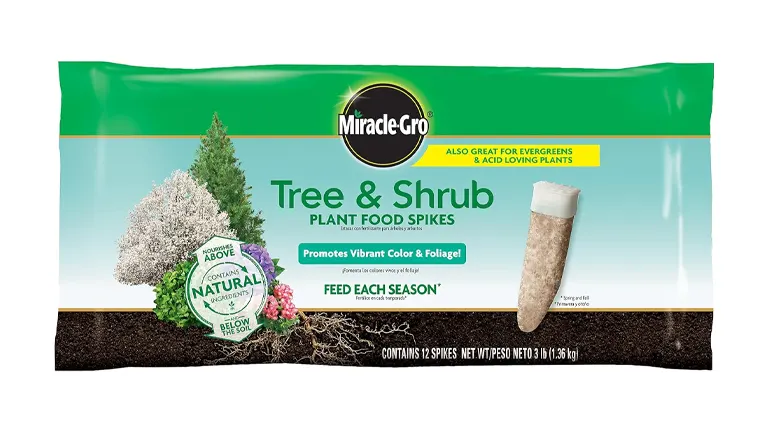
This method not only supports stronger tree and shrub growth but also contributes to the overall beautification of the landscape. Furthermore, these spikes are packed with natural ingredients and are particularly effective for ornamental trees, evergreens, and acid-loving plants, making them a versatile solution for a wide variety of landscape needs.
Pros:
- Precise nutrient delivery at the root zone maximizes efficiency.
- Easy to use with a once-per-season application.
- Suitable for a wide range of plants including evergreens and acid-loving species.
Cons:
- Fixed nutrient ratio limits customization for specific plant needs.
- Requires proper placement near the drip line for optimal effectiveness.
5. Jobe’s Slow Release Evergreen Fertilizer Spikes
Jobe’s Slow Release Evergreen Fertilizer Spikes provide a uniquely efficient and effective method for nourishing evergreen trees and shrubs, such as Cypress, Arborvitae, Pine, and Cedar. These spikes are designed to be easy to use and to minimize waste, hazards, and odors. By delivering a slow-release formula directly to the root zone of these acid-loving plants, they ensure that the nutrients are not washed away by rain or irrigation but instead are absorbed where they are needed most. This targeted approach promotes vibrant growth and health throughout the seasons.
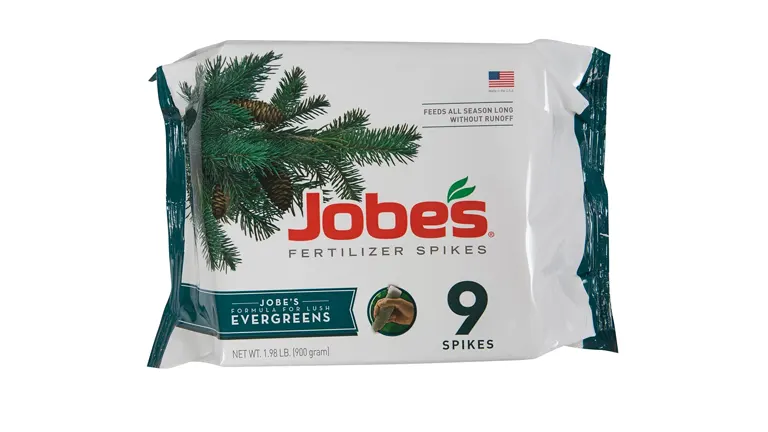
Furthermore, the pre-measured spikes make it simple to apply the right amount of nutrients without the mess and guesswork associated with granular or liquid fertilizers. The formulation of 11-3-4 (NPK) helps in maintaining lush, green growth and robust health, making Jobe’s spikes an essential tool for anyone looking to enhance the beauty and longevity of their evergreen landscaping elements efficiently and effectively.
Pros:
- Pre-measured spikes ensure exact nutrient application without over or underfeeding.
- Easy to insert at the tree’s drip line, reducing nutrient runoff and maximizing absorption.
- Formulated specifically for acid-loving trees and shrubs, promoting healthy, dense growth.
Cons:
- Limited to use with acid-loving plants, not suitable for all tree or shrub types.
- Must be applied twice yearly for optimal results, requiring monitoring and maintenance.
6. Jobe’s 5001T Houseplant Indoor Fertilizer Food Spikes
Jobe’s 5001T Houseplant Indoor Fertilizer Food Spikes are distinguished by their specialized slow-release formula, making them one of the top fertilizer choices for 2025. Designed specifically for a wide range of indoor plants including Fiddle Leaf Fig, Spider Plant, and Snake Plant, these spikes provide a continuous, steady supply of essential nutrients right at the roots, where plants can absorb them most effectively. This method is highly efficient as it reduces the common problem of nutrient runoff seen with liquid and granular fertilizers, ensuring that the plants get the nourishment they need without waste.
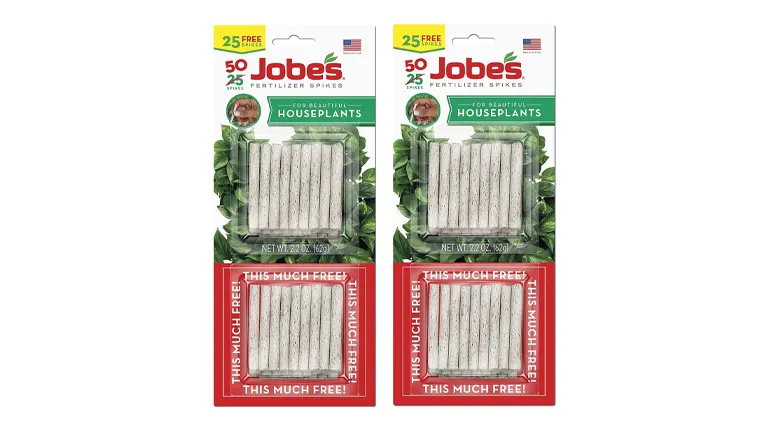
The spikes are pre-measured, which eliminates the guesswork and mess often associated with plant feeding, making them ideal for both novice and experienced gardeners. Their easy-to-use nature and effectiveness in promoting healthy, vibrant plant growth through sustained nutrient release, directly into the soil, position Jobe’s Fertilizer Spikes as a pivotal gardening aid.
Pros:
- Targeted nutrition minimizes waste and runoff.
- Pre-measured spikes make application simple and mess-free.
- Slow-release formula ensures continuous nutrient supply.
Cons:
- Limited to indoor use.
- Needs replacement every 60 days to maintain effectiveness.
7. Miracle-Gro Fruit & Citrus Plant Food Spikes
Miracle-Gro Fruit & Citrus Plant Food Spikes are an exceptional choice for enhancing the health and yield of fruit and citrus trees, making them one of the top fertilizer sticks for 2025. These spikes are specifically designed to nourish trees directly at the root zone, which maximizes nutrient uptake and minimizes wastage due to runoff. By providing a balanced diet with natural ingredients, these spikes promote not only lush foliage but also significantly increased fruit production compared to unfed plants.
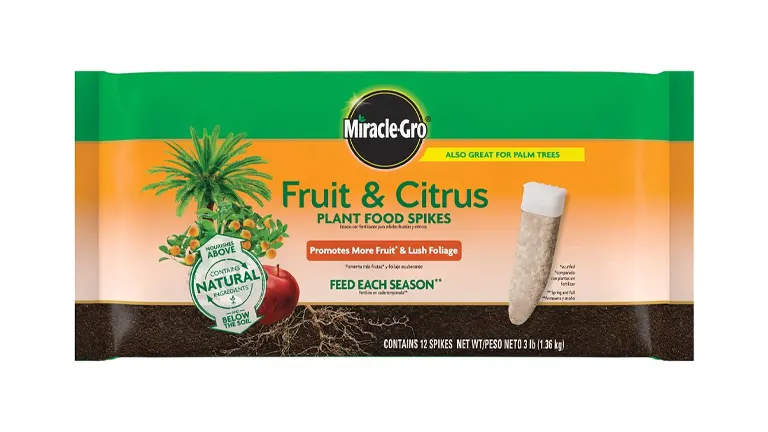
The application process is streamlined and user-friendly, involving simple insertion at the tree’s drip line twice a year, in the spring and fall, which coincides with the trees’ most active growth periods. This targeted feeding schedule ensures that trees receive optimal nutrition during their crucial growth phases, which is essential for the development of strong, healthy fruit and vibrant leaves.
Pros:
- Enhances fruit production and foliage growth.
- Direct root-zone application improves nutrient uptake.
- Easy to use with minimal mess and no hazardous runoff.
Cons:
- Limited to fruit, citrus, and palm trees.
- Requires biannual application to maintain efficacy.
8. The Old Farmer’s Almanac Houseplant & Flower Plant Food Mini Fertilizer Spikes
The Old Farmer’s Almanac Houseplant & Flower Plant Food Mini Spikes are an excellent choice for gardeners seeking to enhance the health and appearance of their indoor and container plants. One of the standout features of these mini spikes is their balanced NPK formulation of 5-5-5, which ensures comprehensive support for plant growth (5% Nitrogen), root development (5% Potassium), and flowering (5% Phosphorus). This all-purpose nutrient mix is ideal for maintaining vibrant colors and lush foliage in a variety of houseplants and flowers, particularly in indoor and low-light conditions where nutrient absorption can be challenging.
The spikes are designed to be user-friendly; they are easy to insert without the need for a cap and are formulated to avoid breakage and dusty residue, making the application process clean and straightforward. Additionally, their slow-release formula provides continuous nutrition every 6-8 weeks, promoting consistent plant growth and stress tolerance without the peaks and troughs of nutrient delivery associated with liquid fertilizers.
Pros:
- Balanced 5-5-5 NPK ratio supports growth, blooms, and root strength.
- Easy to use and mess-free application.
- Continuous feeding improves plant health and bloom vitality.
Cons:
- Needs to be reapplied every 6-8 weeks.
- Specific to houseplants and flower species, not suitable for all plant types.
9. Jobe’s All-Purpose Fertilizer Spikes
Jobe’s All-Purpose Fertilizer Spikes provide a uniquely comprehensive solution for a wide range of plants, making them a standout choice among the top fertilizer sticks for 2025. These spikes utilize an all-natural blend of feather meal, bone meal, and sulfate of potash, delivering a balanced 4-4-4 NPK ratio ideal for flowers, trees, shrubs, vegetables, and more. What sets these fertilizer spikes apart is the inclusion of Jobe’s Biozome—a proprietary blend of microorganisms including Archaea, which enhances the breakdown of nutrients, speeding up results and improving soil conditions throughout the growing season.
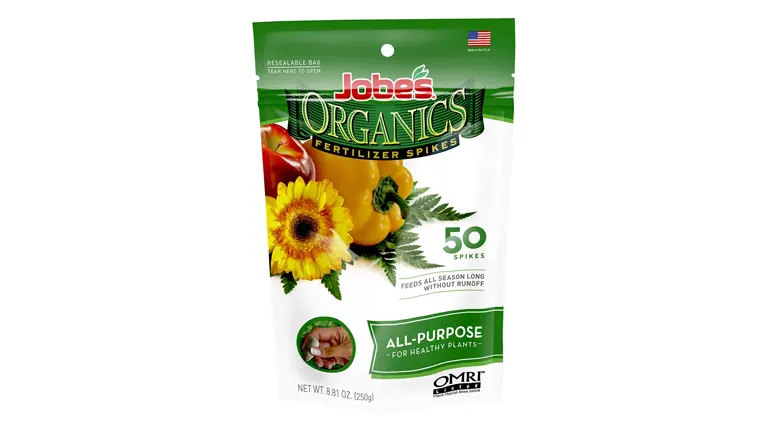
This time-release formula ensures continuous, direct nourishment at the roots, where it’s most needed, without the risk of surface runoff or root burn often associated with liquid or granular fertilizers. The pre-measured, easy-to-insert spikes make fertilizing mess-free and nearly effortless, promoting better growth, drought tolerance, and healthier plants overall.
Pros:
- Provides balanced nutrition suitable for a wide variety of plants.
- Contains Jobe’s Biozome to accelerate nutrient breakdown and soil enhancement.
- Pre-measured spikes ensure precise application without mess.
Cons:
- The uniform NPK ratio may not cater to the specific needs of certain plants requiring more targeted nutrient ratios.
- Organic material in spikes can attract pests if not properly inserted below the soil surface.
10. Laguna Once-A-Year Aquatic Plant Fertilizer Spike
The Laguna Once-A-Year Fertilizer Spike stands out as a premier choice for aquatic plant care, making it one of the top fertilizer sticks for 2025. Specifically formulated for the needs of pond plants, these spikes provide a well-balanced nutrient mix that maximizes plant size and enhances color vibrancy. A unique feature of the Laguna spikes is their temperature-activated release function, which ensures nutrients are dispensed only when the water temperature is above 50 degrees Fahrenheit—aligning nutrient availability with the plants’ active growth phases.
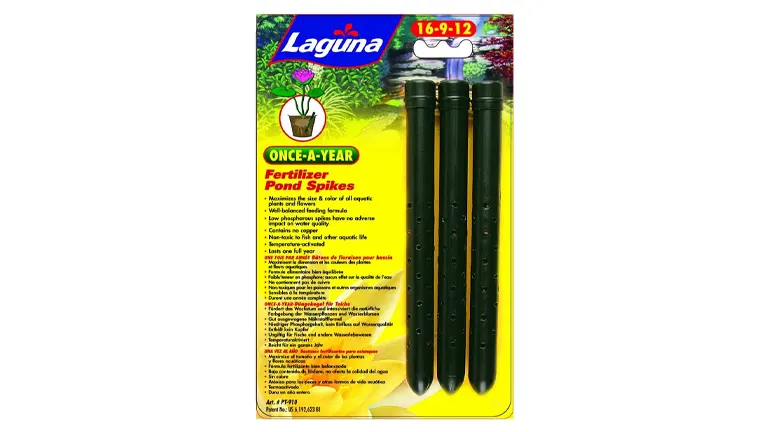
This smart feature prevents waste, making the spikes both economical and environmentally friendly. The formulation is chelated, allowing for maximum nutrient absorption by the plants and minimal uptake by common pond nuisances such as string algae. Additionally, these spikes are designed to last the whole season and are safe for fish and other pond wildlife, as they contain no harmful copper or phosphorous.
Pros:
- Temperature-activated release maximizes nutrient use.
- Safe for aquatic life with no harmful additives.
- Season-long nutrition from a single application.
Cons:
- Limited to use in temperatures above 50 degrees Fahrenheit.
- Only suitable for contained aquatic plants in planting baskets.
How to Use Fertilizer Sticks
Using fertilizer sticks correctly can significantly enhance plant growth by ensuring that nutrients are delivered precisely where they’re needed most — at the roots. Follow this detailed, step-by-step guide to maximize the effectiveness of your fertilizer sticks:
Step-by-Step Application Guide
1. Choose the Correct Fertilizer Stick
- Match the NPK Ratio: The NPK ratio of a fertilizer stick indicates the proportion of nitrogen (N), phosphorus (P), and potassium (K) it contains. Select a fertilizer stick that complements the growth stage and type of plant:
- Nitrogen (N) for leaf development, ideal for leafy greens and lawns.
- Phosphorus (P) for root growth, crucial for establishing young plants and flowering plants.
- Potassium (K) for overall health, enhances disease resistance and drought tolerance.
- Besides NPK, some sticks also include micronutrients like iron, manganese, and zinc, which are vital for plant health. Specialty sticks may target specific needs such as flowering, fruiting, or greening of leaves.
2. Insert Properly:
- Insert sticks about 1-2 inches from the plant stem to avoid damaging new root growth. The depth should reach the root zone but not exceed it, which typically means inserting them 2-4 inches deep, depending on the plant size and pot depth.
- Use the number of sticks recommended on the package, generally one stick per 2 inches of pot diameter.
3. Water Regularly:
- Water immediately after inserting the sticks to start the nutrient release process. Moisture is crucial as it helps dissolve the fertilizer, allowing the nutrients to seep into the soil gradually.
- Keep the soil moist but not waterlogged. Consistent watering schedules help maintain an optimal flow of nutrients to the plant roots.
4. Optimal Timing:
- The best time to apply fertilizer sticks is at the beginning of the plant’s growth season to support a strong start.
- Typically, reapply every two months during the growing season or as directed by the brand. Repotting time is also ideal for adding new fertilizer sticks to provide a nutrient boost to the refreshed soil.
Common Errors to Avoid
- Overuse: Using too many fertilizer sticks can lead to nutrient burn, characterized by brown tips and yellowed leaves, which can damage plant roots.
- Improper Placement: Avoid placing sticks too close to plant stems, which can cause stem burn or uneven nutrient distribution.
- Depth Errors: Inserting sticks too shallow may lead to nutrient runoff during watering, while too deep placement might miss the root zone entirely.
Maximizing Plant Growth with Fertilizer Sticks
To truly maximize the benefits of fertilizer sticks, integrate them with comprehensive gardening practices:
1. Regular Watering:
- Establish a regular watering routine to ensure that the soil is consistently moist, which helps in the gradual dissolution and uptake of the nutrients from the fertilizer sticks.
2. Adequate Sunlight:
- Ensure your plants receive the appropriate amount of sunlight, which can vary significantly:
- Full Sun: Typically 6+ hours of direct sunlight daily, ideal for most flowering plants and vegetables.
- Partial Shade: 3-6 hours of direct sunlight, suitable for plants like ferns and some perennials.
- Full Shade: Less than 3 hours of direct sunlight, preferred by plants such as hostas and hellebores.
3. Periodic Repotting:
- Repot plants every 1-2 years or when they outgrow their current pot, which is evident when roots begin to circle the pot’s base.
- Change the soil during repotting to replenish nutrients that have been depleted, providing a fresh nutrient-rich environment for continued growth.
- Adding new sticks during repotting can kick-start the nutrient supply, crucial for reestablished plants.
4. Complementary Nutrition:
- Occasionally, supplementing with liquid fertilizers that provide micronutrients or adjusting the soil pH with lime or sulfur can enhance the efficacy of fertilizer sticks, especially if the plants show signs of specific deficiencies.
5. Monitoring and Adjustments:
- Watch how your plants respond after applying fertilizer sticks; signs of improvement should be visible in the growth and vigor of the plant.
- Based on plant performance, tweak watering schedules, sunlight exposure, and nutritional inputs to optimize conditions that support robust growth.
Related Post
- How to Fertilize a Mango Tree Effectively: Tips and Tricks for Healthy Growth
- How to Fertilize Apple Trees: Essential Tips for a Bountiful Harvest
- How to Fertilize Lemon Trees: Secrets for Thriving Citrus
- How to Fertilize Avocado Tree: A Step-by-Step Guide for Lush Growth
- How to Fertilize Bougainvillea: A Complete Guide for Stunning Blooms
Conclusion
Selecting the right fertilizer sticks from the top picks of 2025 can significantly enhance the health and productivity of your garden. These sticks provide a convenient and efficient way to deliver essential nutrients directly to the roots, promoting optimal absorption and minimizing wastage. By choosing sticks suited to your plants’ needs and following correct application practices, gardeners can ensure robust plant growth. Combined with regular watering, proper sunlight, and periodic repotting, these fertilizer sticks will help cultivate a lush, vibrant garden.
FAQs
- What makes fertilizer sticks a preferred choice over granular or liquid fertilizers?
Fertilizer sticks provide a no-mess, no-measure solution that’s easier to handle and apply. They deliver nutrients directly to the root zone and offer a slow-release formula, which helps in steady growth over time without the risk of over-fertilization. - How often should I replace my fertilizer sticks to ensure my plants receive consistent nutrients?
Generally, replacing fertilizer sticks every two months is recommended, but this can vary based on the product’s formulation and the plant’s growth rate. Always check the manufacturer’s instructions for the best results. - Can I use fertilizer sticks for both indoor and outdoor plants?
Yes, fertilizer sticks are versatile and can be used for both indoor and outdoor plants. However, it’s important to choose the right type of stick specific to your plant’s environment and nutritional needs. - Are there organic options available among the top fertilizer sticks for 2025?
Yes, organic options are increasingly available, which use natural ingredients beneficial for plants and soil health. These organic sticks not only provide essential nutrients but also improve soil structure and increase microbial activity. - Do fertilizer sticks pose any risk to pets?
Most fertilizer sticks are safe when used as directed, but some can be toxic if ingested by pets. It’s best to choose pet-safe brands or ensure that sticks are fully inserted into the soil and invisible to curious animals. - What should I do if my plant shows signs of nutrient burn after using a fertilizer stick?
If signs of nutrient burn appear (such as scorched leaves or wilted flowers), remove the stick, water the plant thoroughly to help flush out excess nutrients, and avoid re-fertilizing for a few weeks to let the plant recover. - How can I tell if a fertilizer stick is working?
You should see visible improvement in your plant’s growth, such as more vibrant leaves, stronger stems, and increased flowering or fruiting, typically within a few weeks after application. - Can I cut a fertilizer stick in half if it seems too potent for my plant?
It’s not recommended to cut fertilizer sticks as this could alter the release rate of nutrients. Instead, choose a stick with the appropriate nutrient level and size for your plant, or consider placing it further from the plant’s base to reduce intensity.
As we look ahead to 2025, choosing the right fertilizer stick is crucial for optimal plant growth and garden health. Our top 10 picks cater to a variety of plant needs, ensuring vibrant foliage and robust blooms. Whether for indoor pots or outdoor landscapes, these sticks promise ease and effectiveness in every application. Embrace these essentials for a flourishing garden year-round. Happy gardening!

Benjamin Brooks
Forestry AuthorGreetings! I'm Benjamin Brooks, and my journey over the past 15 years has revolved around the fascinating realms of content creation, expertise in snow clearing, and the intricate world of lumberjacking and landscaping. What began as a simple curiosity about the natural world and heavy machinery has evolved into a passionate profession where my love for crafting words intertwines seamlessly with my lumberjacking and garden skills.












Leave your comment